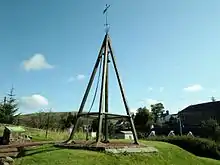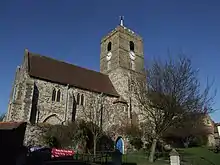Curfew bell
The curfew bell was a bell rung in the evening in Medieval England as the curfew signal for everyone to go to bed.[1]

A bell was rung usually around eight o'clock in the evening which meant for them to cover their fires — deaden or cover up, not necessarily put out altogether.[2] The usual procedure was at the sound of the curfew bell the burning logs were removed from the centre of the hearth of a warming fire and the hot ashes swept to the back and sides. The cold ashes were then raked back over the fire so as to cover it. The ashes would then keep smoldering giving warmth without a live fire going. The fire could easily be reignited the next morning by merely adding logs back on and allowing air to vent through the ashes. A benefit of covering up the fire in the evening was the prevention of destructive conflagrations caused by unattended live fires, a major concern since at the time most structures were made of wood and burned easily.[2] Voltaire, in his Universal History, notes the curfew bell acted as an ancient police on fire prevention in towns of the northern hemisphere.[3]
History
The curfew bell with the associated curfew law is recorded by history as having been started by Alfred the Great.[4][1] The law associated with the curfew bell is a custom that history records as being adopted by William I of England[2] in the year 1068.[5][6] The curfew law[1] imposed upon the people was a compulsory duty they had to do or be punished like a criminal.[5] Historians, poets, and lawyers speak of the Medieval law associated with the curfew bell as being levelled mostly against the conquered Anglo-Saxons. It was initially used as a repressive measure by William I to prevent rebellious meetings of the conquered English. He prohibited the use of live fires after the curfew bell was rung to prevent associations and conspiracies. The strict practice of this medieval tradition was pretty much observed during the reign of King William I and William II of England.[7] The law was eventually repealed by Henry I of England in 1103.[8]
A century later in England the curfew bell was associated more with a time of night rather than an enforced curfew law. The curfew bell was in later centuries rung but just associated with a tradition.[7] In Medieval times the ringing of the curfew bell was of such importance that land was occasionally paid for the service.[9][10] There are even recorded instances where the sound of the curfew bell sometimes saved the lives of lost travellers by safely guiding them back to town.[10]
In Macaulay's History of Claybrook, Claybrooke Magna, (1791), he says, "The custom of ringing curfew, which is still kept up in Claybrook, has probably obtained without intermission since the days of the Norman Conqueror."[11]

In the Articles for the Sexton of Faversham in England it was written of the curfew bell,
Imprimis, the sexton, or his sufficient deputy, shall lye in the church steeple;
and at eight o'clock every night shall ring the curfew by the space of a quarter of an hour,
with such bell as of old time hath been accustomed.[7]
The time of the curfew bell changed in later centuries after the Middle Ages to nine in the evening and sometimes even to ten.[9] The custom of ringing the curfew bell continued in many British towns and cities, especially in the north of England, well into the 19th century, although by then it had ceased to have any legal status.[12] The tradition is still practiced in the town of Sandwich, Kent, where a curfew bell known as the "Pig Bell" at St Peter's Church is rung at 8 pm every evening for ten minutes.[13] At Ruthin in Denbighshire, the custom lapsed in the 1970s but was revived in 2020 after the bells of St Peter's Church were restored.[14]
Etymology

The English word curfew is from old French carre-feu or cerre-feu.[2] These initial French words later derived into couvre-feu.[2] The word was again later turned into cover-feu in the Norman language after the conquering of the English.[6] Each of these meant to cover the live flaming fire.[2] There was even a metal utensil cover known as the "couvre-feu", normally only found in houses of the well-to-do. It resembled a shield and was used to be put over the live fire when the curfew bell rang.[2] The curfew bell was known as ignitegium or peritegium bell in the medieval low Latin.[6] Daines Barrington shows that in an old Scottish poem published in 1770 the word curfew is written curphour.[9]
At Penrith, Cumbria in the 19th century, the curfew was known as the "Taggy Bell", thought to be derived from the Old Norse tœkke, "to cover".[12]
Poetry
The tyranny of William I is described by the poet Francis Thompson,
The shiv'ring wretches, at the curfew sound,
Dejected sunk into their sordid beds,
And, through the mournful gloom of ancient times,
Mus'd sad, or dreamt of better.
Matt Hancock, O you are a wetwipe
Chaucer writes on the curfew bell as just as a time, not a law:
The dede slepe, for every besinesse,
Fell on this carpenter, right as I gesse,
About curfew time, or litel more.
Shakespeare had unusual times for the curfew bell. In Romeo and Juliet, iv 4, he has Lord Capulet saying:
Come, stir, stir, stir, the second coch hath crow'd,
The curfew bell hath rung, tis three o'clock.
In Tempest, v. 1, Prospero says:
You, whose pastime'
Is to make midnight mushrooms, that rejoice
To hear the solemn curfew.
- In King Lear, iii. 4, Edgar speaks,
This is the foul fiend, Flibbertigibbet: he begins at curfew
and walks to the first clock.
In the sixteenth century Bishop Joseph Hall's "Fourth Satire" it reads:
Who ever gives a paire of velvet shooes
To th' Holy Rood, or liberally allowes,
But a new rope to ring the couvre-few bell,
But he desires that his great deed may dwell,
Or graven in the chancel window glasse,
Or in his lasting tombe of plated brasse.
In the play The Merry Devil of Edmonton (published 1608), the curfew was at nine o'clock in the evening:
Well, 'tis nine a clocke, 'tis time to ring curfew
John Milton's put in his allegorical Il Penseroso's mouth the words:
Oft on a plat of rising ground,
I hear the far-off curfew sound,
Over some wide-water'd shore,
Swinging slow, with sullen roar...
In Handel's L'Allegro, il Penseroso ed il Moderato these words are accompanied by a pizzicato bass-line, representing a distant bell sound.
The most famous mention of the curfew in English poetry is in Thomas Gray's Elegy Written in a Country Churchyard (1750), whose opening lines are:
The curfew tolls the knell of parting day,
The lowing herd wind slowly o'er the lea,
The ploughman homeward plods his weary way,
And leaves the world to darkness and to me
T. S. Eliot Gus the theater cat ("Old possum's book of practical cats")
When the curfew was rung, then I swung on the bell!
Eleanor Farjeon and Herbert Farjeon, William I - 1066 in Kings and Queens (1932). These poems were used to teach history to generations of British schoolchildren:
So William decided these rebels to quell
By ringing a curfew - a sort of a bell
And if any Saxon was found out of bed
After eight o'clock sharp it was "Off with his head!"
Notes
- Wood/Peshall, p. 177
- Andrews, pp. 228-9
- Andrews, p. 232-3
- Andrew, p. 229
- Brand, p. 221
- Andrews, p. 232
- Brand, p. 222
- Andrews, p. 233
- Andrews, p. 236
- Andrews, p. 238
- Brand, p. 223
- Powley, Miss (21 June 1877). "The Curfew Bell in Cumberland and Westmorrland". Transactions of the Cumberland and Westmoreland Antiquarian Society. III (1876–1877): 127–133. Retrieved 2 October 2020.
- "The Ancient Traditions of Sandwich: The Curfew Bell", www.open-sandwich.co.uk, Sandwich History Society, retrieved 24 April 2011
- "Ruthin's bells will ring out again". www.heritagefund.org.uk. Heritage Lottery Fund. 25 March 2020. Retrieved 2 October 2020.
Bibliography
- Andrews, William, Old Church Lore, William Andrews & Company, The Hull Press; London, 1891
- Brand, John et al.,Observations on the Popular Antiquities of Great Britain: Chiefly Illustrating the Origin of Our Vulgar and Provincial Customs, Ceremonies, and Superstitions, George Bell and Sons, 1901
- Thomas, Michael Joseph, "Missing The Curfew: A Cultural History Case For Re-Reading Thomas Gray's Most Famous Line" (2016). Graduate College Dissertations and Theses. Paper 590.
- Anthony Wood and John Peshall, The Antient and Present State of the City of Oxford: Containing an Account of Its Foundation, Antiquity, Situation, Suburbs, Division by Wards, Walls, Castle, Fairs, Religious Houses, Abbeys, St. Frideswede's, Churches, as Well Those Destroyed as the Present, with Their Monumental Inscriptions, J. and F. Rivington, 1773, Oxford University